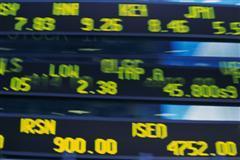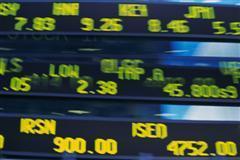| Home | About | Archives | RSS Feed |

@theMarket: This Is the Year for Commodities
 Last year, precious metals garnered the headlines and the attention of most investors. Gains in gold, silver, palladium and platinum left stocks in the dust. This year may well be the year for base metals, food and energy to outshine precious metals and the stock market overall.
Last year, precious metals garnered the headlines and the attention of most investors. Gains in gold, silver, palladium and platinum left stocks in the dust. This year may well be the year for base metals, food and energy to outshine precious metals and the stock market overall.
While gold and even silver's rise last year was more about concerns over currencies and inflation, the rise in basic materials is largely a play on the coming global economic recovery. The investment theme is simple: while world economies are beginning to grow, nations and companies rev up production in order to meet demand and therefore the demand for commodities increase proportionately. At the same time, new wealthier, middle-class consumers in developing countries, such as China and India, demand a better diet and now have the money to afford such delicacies as beef, pork, chicken as well as different grains and even bread and pastries.
This scenario is neither new nor original. The prices of aluminum, cooper, steel, lead, zinc and a host of other hard metals as well as wood and paper and other basic materials have been on the rise over the last few years simply because certain developing nations such as China have been demanding more of these commodities to both re-build the infrastructure of their countries and also export to developed nations such as the U.S. and Europe. Now that global economic growth is at hand, demand for these materials will continue to expand, and at an accelerated rate.
Some of these commodities, like rare-earth metals for example, have recently skyrocketed in price causing a mini-bubble in that sector. We can expect more of the same.
Back in September of last year, readers may recall my column "Wheat, Weather and the Grocery Shelves" in which I warned that food prices were heading much higher.
"The real increases in food prices are still waiting in the wings until the world's economies are on firmer footing. Once people can afford to spend again, prices are expected to move up quickly in commodities across the board."
Well, folks, that time has come. Wall Street analysts forecast that food prices could rise anywhere from 2.5 to 4 percent this year versus 1.5 percent in 2010. A variety of factors including weather, population growth, the rise of the emerging market consumer as well as global economic growth have lit a fire under commodities as mundane as sugar, corn and cotton.
Since June, corn prices are up 94 percent, soybeans have gained 51 percent and wheat is up over 80 percent. Just this week, the U.S. Agricultural Department reduced its estimates for global harvests of some important crops, as well as increased their demand forecasts for commodities overall. It seems a safe bet that when looking for new investments this year, commodity-producing companies and countries should be high on your list.
As for the markets overall, all three averages are grinding higher as the second week of January comes to a close. I still expect a pullback of sorts (risk of 3-4 percent) but that would simply be another opportunity to buy stocks, given that I think the stock market will provide rewards of 15-20 percent between now and August. Given that kind of risk/reward scenario, I am a buyer of equities on every dip.
Bill Schmick is an independent investor with Berkshire Money Management. (See "About" for more information.) None of the information presented in any of these articles is intended to be and should not be construed as an endorsement of BMM or a solicitation to become a client of BMM. The reader should not assume that any strategies, or specific investments discussed are employed, bought, sold or held by BMM. Direct your inquiries to Bill at 1-888-232-6072 (toll free) or e-mail him at wschmick@fairpoint.net. Visit www.afewdollarsmore.com for more of Bill's insights.
| Tags: metals, commodities |
The Independent Investor: The Business of Beauty
 Don't go trying some new fashion Don't go trying some new fashionDon't change the color of your hair ... I could not love you any better I love you just the way you are.  |
| — Billy Joel |
It is a "recession-proof" business with new openings forecasted to grow by 20 percent between now and 2018. Although these professions require state certification and courses in biology, chemistry, nutrition and herbology, hairdressing, hairstylists and cosmetologists can hardly fill the demand for their services.
The beauty of hair is that it grows; in fact, it is the fastest-growing tissue in the human body. The average human scalp harbors over 100,000 strands, which, if treated kindly, can have a lifespan of five and one half years. And today's female baby boomers are visiting salons at an increasing rate in order to preserve and enhance one of women's most alluring qualities. The nation's hairdressers are working overtime to accommodate these millions of women who keep coming back for a variety of services ranging from washing, shampooing, cutting, coloring and styling their hair.
 Women spend well over $50 billion a year at the salon. That's in addition to the billions they are spending on shampoo, conditioners, hairsprays, gels, mousses and hair coloring. And there is evidence that women actually spend more in a recession since it helps make one feel better about themselves in the face of economic uncertainty.
Women spend well over $50 billion a year at the salon. That's in addition to the billions they are spending on shampoo, conditioners, hairsprays, gels, mousses and hair coloring. And there is evidence that women actually spend more in a recession since it helps make one feel better about themselves in the face of economic uncertainty.
"Even though the economy is not doing so well, my business is just fine," reports Theresa Smith, the owner of Sheffield's Mystique Salon for the last 20 years.
Hairdressing dates back to at least the 1700s when the ladies (and men) of the French Court of Louis XV vied to present the most dramatic appearance possible at balls and other state functions. Powders, pastes, baskets, buns, and even live birds and cascading waterfalls were part of the daily parade of excesses. In this country, hairdressers created the "bob" in the roaring Twenties, the “beehive” during the “Mad Men” years of the 1960s and a long series of television-inspired dos inspired by everyone from Jennifer Aniston to Farrah Fawcett.
"Back in 1983 when I got started," recalls Tracy Wilson, soon to be owner of Indulgence Hair Salon in Pittsfield, "it was all about big hair, big hair spray and scary chemicals. Things have changed, and for the better."
There are a little over 800,000 barbers, cosmetologists and other personal appearance workers in America and about 44 percent of them are self–employed. But cutting, coloring, styling, curling, straightening, giving scalp treatments and massages is hard work. Many in the business, especially those who own their own salon, put in more than a 40-hour week, which can include evenings and weekends. Many hairdressers (29 part time) are part time and many of those work two jobs.
It's a business where the newcomer must pay their dues.
"Here in Massachusetts, the state requires 1,000 hours of practical work in addition to your course studies and once you pass the exam you're licensed as an apprentice," explains Tracy. "Then you are required to work an additional 2,000 hours, roughly two years in a salon before you are a licensed hair stylist."
During that period the fledgling stylist starts at minimum wage plus commissions but will likely only bring in between $18,000 to $20,000 a year.
"I estimate someone who works hard, attracts a returning clientele and continues their education could be making an average of $45,000 a year in this region after five years," says Theresa Smith.
"Education is key," explains Tracy Wilson. "Here at Indulgence we require at least two outside courses and 4 to 6 in-salon courses each year. It is an extremely competitive business and you need to be on the cutting edge of knowledge in a variety of areas."
If the stylist has acquired the confidence, presentation skills and remains serious about her continuing education, the normal progression after five or so years is to open one's own salon.
"We have eight people working here," says Wilson, "and I'm thinking of hiring a massage therapist next year."
Today's female clientele expects more than just a haircut. The entire experience must be of a quality that convinces them to return. The baby boomer generation is the largest segment of women who frequent salons and they are visiting them more often as the Graying of America sets in.
"Boomers are easily 75 to 80 percent of our business and their chief request is hair coloring," says Wilson.
Both women agree that it is a lot of hard work but they both love what they do. I asked Mystique's Theresa Smith if the beauty business might be a viable avenue for the area’s unemployed to either begin or embark on a second career.
"Absolutely!" she said as she greeted yet another loyal customer.
It seems the business of beauty is a positive for those on both sides of the hair dryer.
Bill Schmick is an independent investor with Berkshire Money Management. (See "About" for more information.) None of the information presented in any of these articles is intended to be and should not be construed as an endorsement of BMM or a solicitation to become a client of BMM. The reader should not assume that any strategies, or specific investments discussed are employed, bought, sold or held by BMM. Direct your inquiries to Bill at 1-888-232-6072 (toll free) or e-mail him at wschmick@fairpoint.net. Visit www.afewdollarsmore.com for more of Bill's insights.
| Tags: beauty |
@theMarket: No Gain, No Pain
 Markets did little in the first week of the 2011. All three averages barely budged as investors waited for some new catalyst that might hint at the near-term direction of the market. Friday's disappointing unemployment data gave them that excuse.
Markets did little in the first week of the 2011. All three averages barely budged as investors waited for some new catalyst that might hint at the near-term direction of the market. Friday's disappointing unemployment data gave them that excuse.
Only 103,000 jobs were created in December while some economists were forecasting as many as 400,000 jobs for the month. I'm not concerned about the monthly unemployment data or about a possible pullback in the next few days or weeks. While the overall market has vacillated lately, the commodity sector has been undergoing a good old-fashioned correction. Given that commodity stocks have largely led the market higher for the last year, in my opinion, declines in that area are telegraphing a coming slide in the overall stock market.
A pullback, when stocks are overextended like they are at the moment, simply allows the overall market to prepare for further gains in the future. A 2 to 4 percent dip therefore, while painful in the short term, would be barely be a blip in the coming move higher.
For those who missed last week's column, my prediction for the S&P 500 Index for 2011 is north of 1,450-1,500. We could see gains of between 15 to 20 percent before we hit another roadblock. As a result, I would advise even the most conservative investor to take advantage of any dip to re-orient their portfolio toward equities in 2011.
Remember, however, that we are still in a secular bear market and will be for the foreseeable future. What we are experiencing (and have been since March 2009) is a rally (called a secular bull market) within this long-term downtrend. It is a period where a buy and hold strategy will only result in losses to your portfolio. We have had similar periods in stock market history, with the most recent occurring between the years of 1966 and 1982.
During that period there were several opportunities, lasting from several months to a few years, where great gains were made, with similar opportunities to lose a great deal of money.
Consider this a market of seasons where at times you plant seeds, watch your crops grow, and then harvest them before the winter arrives. Right now we're in planting season (buying stocks) because the climate (economic environment) is conducive to growth. The economy will surprise investors this year by growing a little more than we expect (possibly 3.5 percent). The Fed will continue to keep short-term rates low while supporting the stock market using this "easy money" strategy. At the same time, the Obama administration's wide range of tax cuts and benefit extensions as well as investment tax breaks for our corporations will further boost spending.
Down the road, there still are several clouds looming on the horizon that may at some point de-rail this happy scenario. Although the much-feared specter of hyperinflation is overblown, in my opinion, we could see a sharp spike in long-term interest rates later in the year. The financial problems of European banks also worry me, and their problems have not gone away.
"But everyone I talk to is bullish," protests one investor from Pittsfield, who worries that the consensus is usually wrong.
He is right that my forecasts are very much in line with The Street. Friday, for example, Goldman Sachs upgraded their S&P 500 forecast to 1,500. Sometimes, the consensus and the markets can be in sync. I believe that the economic evidence is so overwhelmingly positive that, barring a new major negative, the near-term future of the markets is fairly certain.
Even Fed Chairman Ben Bernanke in his discussion Friday with Senate Budget Committee commented that he sees "increased evidence that a self-sustaining recovery" is unfolding as well as a "moderately stronger" economy this year. I'll stick with the Fed and bet on the market.
Bill Schmick is an independent investor with Berkshire Money Management. (See "About" for more information.) None of the information presented in any of these articles is intended to be and should not be construed as an endorsement of BMM or a solicitation to become a client of BMM. The reader should not assume that any strategies, or specific investments discussed are employed, bought, sold or held by BMM. Direct your inquiries to Bill at 1-888-232-6072 (toll free) or e-mail him at wschmick@fairpoint.net. Visit www.afewdollarsmore.com for more of Bill's insights.
| Tags: bulls, recovery, interest rates |
The Independent Investor: Exchange-Traded Funds Catch On
 Exchange-traded funds (ETFs) assets have recently surpassed the $1 trillion mark as investors continue to discover these securities are a welcome alternative to both stocks and mutual funds. Adding $122 billion to this growing class of funds in 2010, investors and experts alike believe ETFs will continue to grow as markets become highly correlated in the years ahead.
Exchange-traded funds (ETFs) assets have recently surpassed the $1 trillion mark as investors continue to discover these securities are a welcome alternative to both stocks and mutual funds. Adding $122 billion to this growing class of funds in 2010, investors and experts alike believe ETFs will continue to grow as markets become highly correlated in the years ahead.
Readers are aware that I have written a number of columns on ETFs over the years. But for those new to the concept, I'll quote Wikinvest's definition of an ETF:
 An exchange-traded fund (ETF) is an investment product — similar to a mutual fund — that trades on a stock exchange. Most ETFs track major stock indices or industry sub-sectors, which allows investors to get exposure to either the entire market or specific sectors with a single purchase. Unlike a mutual fund, an ETF's holdings — the investments it makes — are always known (its components are simply the weighted components of the index it tracks). While mutual funds often aim to 'beat' the market or the sector they track, ETFs usually aim only to track the market and match its performance, good or bad. As a result, ETFs often charge lower fees than mutual funds, and are known as inexpensive ways for investors to invest in the market as a whole or specific subsectors. ETFs also have lower-expense ratios because they are not actively managed. In most cases, this results in lower management fees and lower turnover costs. An exchange-traded fund (ETF) is an investment product — similar to a mutual fund — that trades on a stock exchange. Most ETFs track major stock indices or industry sub-sectors, which allows investors to get exposure to either the entire market or specific sectors with a single purchase. Unlike a mutual fund, an ETF's holdings — the investments it makes — are always known (its components are simply the weighted components of the index it tracks). While mutual funds often aim to 'beat' the market or the sector they track, ETFs usually aim only to track the market and match its performance, good or bad. As a result, ETFs often charge lower fees than mutual funds, and are known as inexpensive ways for investors to invest in the market as a whole or specific subsectors. ETFs also have lower-expense ratios because they are not actively managed. In most cases, this results in lower management fees and lower turnover costs. |
Now given that they are cheaper, trade all day, (unlike mutual funds that trade once a day after the market close), and outperform mutual funds the majority of the time, why haven't they driven mutual funds out of business?
The answer is two-fold: commitment and self-control.
Some investors believe that they can outperform the market if they pick the right mutual fund manager. There are fund managers out there who consistently do that although the numbers are less than 25 percent of all mutual funds.
Although ETFs will generate the same returns as their underlying index, many investors are guilty of buying and selling ETFs at the wrong time. Emotions sometimes get in the way of objective investing. ETFs, given that they trade all day like stocks, are far easier to dump (or chase) when the markets suddenly turn against you while mutual funds charge a penalties for such short term trading. And unlike ETFs, they can only be purchased once a day after the stock market closes.
Nonetheless, experts expect the demand for ETFs will continue to grow. Financial giants such as Charles Schwab and TD Ameritrade have begun to offer their own ETFs and are offering investors incentives to switch their buying to their house brand by offering commission-free trades and undercutting competitors in the expense ratios area.
The recent proliferation of exchange-traded notes or ETNs that invest in commodities such as gold bullion, sugar, platinum and a host of other commodities have also attracted the interest of investors. Many of us have found a cheap, viable approach to investing (or speculating) in a field long closed to all but the best-heeled professionals. But buyers beware, ETNs are taxed differently then ETFs (even in tax–deferred accounts such as IRAs).
Nonetheless, ETNs have been so successful in attracting new money that there have been several articles criticizing ETNs for artificially inflating the price of commodities such as oil, and causing spikes in consumer stables like gasoline.
Finally, the fact that most stock markets have become highly correlated makes buying individual stocks or even mutual funds less efficient. If everything is going up together an ETF enables the investor to buy into sectors, countries, regions or even world indexes quickly. They allow the little guy to truly become a global investor, although how one performs requires that same old self-control and commitment that has been around for centuries. The more things change, the more they stay the same.
Bill Schmick is an independent investor with Berkshire Money Management. (See "About" for more information.) None of the information presented in any of these articles is intended to be and should not be construed as an endorsement of BMM or a solicitation to become a client of BMM. The reader should not assume that any strategies, or specific investments discussed are employed, bought, sold or held by BMM. Direct your inquiries to Bill at 1-888-232-6072 (toll free) or e-mail him at wschmick@fairpoint.net. Visit www.afewdollarsmore.com for more of Bill's insights.
| Tags: ETF, mutual funds |
@the Market: What Will the New Year Bring?
 |
Now that we have safely tucked away the year 2010 with the S&P 500 Index up 12.9 percent, will we enjoy a similar or better return in 2011? Clearly, the majority of investors are looking for another up year. I believe that’s a safe bet, at least for the first half of the year.
Since March of 2009, I have been forecasting an up market and have been correct in doing so. Sure, during that time period we have had our ups and downs largely based on worries of a "double dip" recession here in the U.S. and financial problems in Europe. I discounted both events but also warned investors that the markets would react negatively. I considered those sell offs a buying opportunity. In hindsight, where I have erred was in estimating the severity and duration of some of these pullbacks.
For example, I did identify an interim top in the markets back in April (at around the S&P 500 1,220) but was too bearish in estimating the index would decline to 950 before the correction would be over. Instead, the S&P 500 tested and re-tested the 1,035 level and then resumed its climb in September.
The low in the markets coincided with The Federal Reserve’s announcement that they planned to launch a second quantitative easing. It was enough to reverse my cautious stance, admit my mistake, and turn positive on the markets. I have been bullish since the fall and have no reason to change my mind now that we are entering the New Year.
I believe the economy will hold positive surprises for us in the first half of the year. Growth will exceed most economists’ forecasts and although unemployment will remain high, we will see a steady improvement over the next several months as American corporations hire more workers. The housing market will also surprise us as well. I firmly believe 2010 saw the bottom in housing prices and sales. In 2011, we should see a small but steady improvement in all but the most bombed-out housing markets. The Fed will stay accommodative as well keeping short-term rates low and equities higher.
All this good news should translate into higher prices in global stock markets and in commodities. The S&P 500 could see gains of 15 percent-plus before the year is over and depending upon your investments, that gain could be substantially higher. However, we will still be subjected to corrections. Right now, for example, as a result of this Christmas rally, all three indexes are over extended and in need of a pullback. This could occur as early as next week or later in the month. These mini-corrections are an inevitable cost of doing business in equity
There is also a distinct possibility that later in the year the stock market will get ahead of itself. After all, markets vacillate between fear and greed. As the averages trend higher, investors tend to believe markets will go higher still. Valuations get out of whack or events occur that change the game and the markets correct. So don’t be surprised if I sound a note of caution as early as this spring. Rest assured that somewhere out there lurks another substantial pullback (greater than 10 percent). Hopefully, I will be on the job and lucky enough to identify it when it occurs.
However, for now, I see clear sailing ahead with only a few minor squalls in the stock markets. As for fixed income, clearly, interest rates have seen their lows in the U.S. Treasury and Municipal bond markets. That multi-decade Bull Run is over and investors would be well advised to steer clear of those areas. Commodities will continue to gain although this year I suspect precious metals will take a back seat to their more mundane cousins such as agricultural products, base metals and materials.
All in all, I feel as positive about the markets now as I did at this time last year. I guess the difference today is that I am expecting more people to enjoy the benefits of an economic expansion than ever before. And that is a real reason to celebrate, so happy New Year to you and yours.
Bill Schmick is an independent investor with Berkshire Money Management. (See "About" for more information.) None of the information presented in any of these articles is intended to be and should not be construed as an endorsement of BMM or a solicitation to become a client of BMM. The reader should not assume that any strategies, or specific investments discussed are employed, bought, sold or held by BMM. Direct your inquiries to Bill at 1-888-232-6072 (toll free) or e-mail him at wschmick@fairpoint.net. Visit www.afewdollarsmore.com for more of Bill's insights.
| Tags: forecast |

